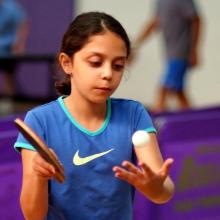The students that I’m currently coaching range from about 100-2200 USATT rating. For each of these students they are at a different learning stage. In this blog posting, I will be giving the progressive order of the strokes and the order in which they should be learned. If you are having trouble with one of the strokes listed below, see if you have perfected these items in order of priority. Note: You might have missed one of the important aspects! J
Serve
1. Ball control
2. Spin
3. Height
4. Depth
5. Placement
6. Spin type variation
7. Spin amount variation
When learning serves, many players try to develop very tricky motions before developing enough spin. If you learn to have moderate to heavy spin, then next learning variations with side-spin combos and no-spin is quite easy. Focus on having 1 good motion then learning several variations to that motion.
Drive
1. Ball control
2. Set racket angle
3. Placement
4. Speed
One of the first strokes that you will learn as a beginner is the drive. Focus on keeping your angle set and being consistent. Speed is at the bottom of the priority list.
Push
1. Ball control
2. Spin
3. Height
4. Depth
When applying backspin to the ball, it tends to float up if you power the push. Focus on control and spin, not power. If you are an advanced player, then give short and long variations with even a bit of sidespin.
Loop
1. Body balance
2. Weight transfer
3. Spin
4. Placement
5. Variation
Because the loop is a longer swing requiring more effort from the legs and torso, it is absolutely critical that you first develop good footwork so that you can have good balance when learning to loop.
Serve Return
1. Reading the spin
2. Footwork
3. Stroke with spin
4. Return to ready position
The first step in learning to return serve is learning how to read spin. The direction that the ball will jump off your paddle is the direction that the opponent’s racket went. As you learn to read the spin, adjust your stroke accordingly and learn to return with spin. When applying spin to your return, your opponent’s spin will affect you less and you will have way more control.
Smash
1. Reading the spin
2. Footwork
3. Contact Point
4. Power
5. Placement
If you can properly read the spin, then you will know how the ball will jump once it contacts your side of the table, then you can properly adjust your positioning. The most common smashing error is due to footwork problems. Learn to get into good position and the small will become much easier!
The Order of Success

Learn the important aspects of improving your strokes!
Category:



